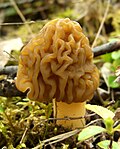Paraphyses are erect sterile filament-like support structures occurring among the reproductive apparatuses of fungi, ferns, bryophytes and some thallophytes...
1 KB (148 words) - 11:10, 6 February 2024
cells develop into sterile cells called cystidia (basidiomycetes) or paraphyses (ascomycetes). Cystidia are often important for microscopic identification...
3 KB (295 words) - 22:15, 18 September 2023
stinkhorns. Interspersed among the asci are threadlike sterile cells called paraphyses. Similar structures called cystidia often occur within the hymenium of...
47 KB (4,978 words) - 12:23, 21 May 2024
space, with both ends attached to the gills, help together by clasping paraphyses. As the gill expands the cystidium breaks away from one gill and projects...
12 KB (1,275 words) - 23:07, 3 May 2024
the shape of the spores (those of T. cupularis being narrower) and the paraphyses (those of T. cupularis lacking the distinctive lobed tips of T. catinus)...
2 KB (175 words) - 04:32, 10 January 2024
have a cylindrical shape, with dimensions of 115–125 by 8–10 μm. The paraphyses (sterile filamentous cells interspersed among the asci) are cylindrical...
23 KB (2,310 words) - 22:05, 22 April 2024
often contain two small oil droplets, and measure 11–15 by 6–10 μm. The paraphyses are slender, contain septa, and are slightly enlarged above. The species...
10 KB (822 words) - 03:56, 10 March 2024
Toninia, such as Psora-type asci, a non-amyloid hymenial gelatin, and paraphyses that were more tightly bound together, topped with a distinctly pigmented...
9 KB (884 words) - 15:18, 5 March 2024
including functionless stipules and carpels, leaf reduction of Equisetum, paraphyses of Fungi. Well known examples are the reductions in floral display, leading...
32 KB (3,876 words) - 05:01, 7 May 2024
bodies barely exceeding 1–2 cm and has polymorphic, often moniliform paraphyses and predominantly 3-septate spores. Geoglossum dunense was described as...
6 KB (610 words) - 00:27, 23 May 2024
both antheridia and archegonia, either together or on separate branches. Paraphyses – sterile hairs surrounding the archegonia and antheridia. Perianth –...
82 KB (10,353 words) - 06:29, 12 May 2024
are eight-spored, 223–300 by 19–20 μm, cylindrical, and hyaline. The paraphyses are filamentous, cylindrical, 5.8–8.8 μm wide, and hyaline. The hyphae...
25 KB (2,713 words) - 17:50, 16 May 2024
dehiscence (fruit body opening) is caused by the pressure exerted by swollen paraphyses—sterile (i.e., nonreproductive) cells that are interspersed between the...
33 KB (3,468 words) - 08:17, 27 April 2024
two sterigma and lateral protuberances, encrusted hyphae that resemble paraphyses, and spherical spores. Gorjón, Sergio P.; Greslebin, Alina G.; Rajchenberg...
2 KB (136 words) - 01:09, 25 January 2024
color and septation of the ascospores, and shape and ornamentation of the paraphyses. Geoglossum was described by Christian Hendrik Persoon in 1794, who created...
19 KB (1,541 words) - 08:31, 26 May 2024
Boudier believed that the large, curved ascospores and the rare and short paraphyses were sufficiently distinct to warrant a new genus to contain the single...
27 KB (2,589 words) - 19:04, 18 May 2024
portion of hymenium showing the longitudinally interwoven hyphal ends or paraphyses and some probasidia; b, three spore-bearing organs; s, spores. × 640"...
8 KB (875 words) - 00:05, 17 May 2024
5 μm at the capitate (club-like) terminal cells. Some paraphyses transform into oil paraphyses, usually containing one or two oil cells. The spores are...
6 KB (684 words) - 05:11, 28 May 2024
appearance and resembles a membrane, it is sessile, it does not have paraphyses, its asci are oblong, and its sporidia are biseriate and have an oblong-elliptical...
28 KB (2,267 words) - 07:29, 27 April 2024
differences in microscopic characteristics, such as spores, asci, and paraphyses. First described in 1796 as a species of Geoglossum, the fungus has gone...
21 KB (1,907 words) - 04:24, 12 May 2024
greenish-brown to dark brown and measures 14–28 μm in thickness. The paraphyses, which are filamentous structures within the ascomata, are simple, long...
7 KB (598 words) - 01:42, 14 May 2024
ascospores and paraphyses. Paraphyses are sterile cells' often with swollen tips and are at high turgor pressure. Tips of the paraphyses are very tightly...
5 KB (354 words) - 20:07, 14 October 2023
spore-bearing layer) does not contain interspersed particles, and the paraphyses (sterile filaments within the hymenium) are unbranched. The ascospores...
8 KB (638 words) - 07:01, 13 May 2024
spindle-shaped, contains two to four oil droplets, and measure 14–25 by 7.5–9 μm. Paraphyses are shaped like narrow cylinders about 2 μm thick, and have rounded tips...
3 KB (262 words) - 17:33, 10 January 2024
features such as its thinner cortical layer in the thalline exciple, paraphyses of uniform thickness, longer ascospores, and the absence of an algal layer...
6 KB (558 words) - 12:07, 23 December 2023
and clear, while the epithecium is gray and granular. The unbranched paraphyses have smooth tips, and periphysoids are present to indistinct. The asci...
7 KB (687 words) - 17:03, 1 October 2023
only at the apex. Its cerebriform (brain-like) pileus, brown-pigmented paraphyses and biguttulate cyanophilic spores, are all typical gyromitroid features...
2 KB (151 words) - 14:39, 17 February 2024
structures) are club-shaped and contain 2-4-8 spores, accompanied by paraphyses (sterile filaments interspersed among the asci). The spores are elliptical...
7 KB (435 words) - 05:11, 13 May 2024
characterised by a thin dome at the apex, a distinct structural feature. The paraphyses (sterile filaments among the asci) in this genus are branched at the tips...
6 KB (435 words) - 03:41, 22 January 2024
do not have an algal layer. Within, the thread-like structures, called paraphyses, show a dense branching pattern towards their top. The underneath layer...
4 KB (424 words) - 01:10, 3 November 2023





















